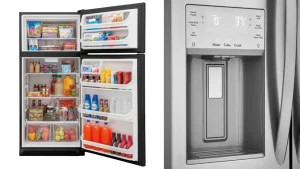Updated on March 13, 2023
To prevent confusion with a deep freezer, the term “fridge” is used to describe a refrigerator that includes both a cooling unit and a freezer.
Refrigerator vs. Fridge: Which Is Better?
All across the globe, people use refrigerators as a cooling equipment in their homes. Items may be kept at various temperatures in two separate compartments. Refrigerator vs. freezer: The bigger compartment maintains food and other perishables at a temperature just above freezing point (3-5 degrees Celsius), while the smaller section is used to make frozen drinks in hot areas. The term “fridge” is also often used to describe the same appliance. As though they were synonyms, people use the two terms interchangeably. Check out the differences between refrigerators and refrigerators.
To prevent confusion with a deep freezer, the term “fridge” is used to describe a refrigerator that includes both a cooling unit and a freezer. Separate sections allow for the storage of both ice cream and vegetables within the refrigerator, while the freezer is reserved only for the storage of food and medications that need temperatures below 0°F. In actuality, a refrigerator is a combination of a cooling equipment and a tiny freezer, making it a refrigerator/freezer combo. You can no longer refer to it as a freezer, therefore the new term “fridge” was invented.

When you remove the first and last few letters of the word “refrigerator,” you get the shorter term “fridge,” however there are some subtle differences. Refrigerators, on the other hand, are never referred to as “fridges” in the business since it gives the item a casual aspect. The term “refrigerator” is a bit of a slog to say out loud. Also, writing so many alphabets is cumbersome. Consequently, the term “fridge” is both comfortable to say and write.
Refrigerators have a lower temperature than refrigerators. There is no way to freeze water in a refrigerator, but there is in a freezer. Ice cream and other goods that don’t need a high temperature are kept in the refrigerator, while food is kept in the fridge. When a refrigerator is complete, it contains a refrigerator. There is a refrigerator in every refrigerator.
While most individuals know what a fridge and refrigerator are, they’re stumped as to the distinction between the two devices.
Preserving goods is an important function of both of these pieces of equipment since they both maintain a constant temperature.
Their disparities, on the other hand, are startling, as we’ll see in the next piece. Let’s take a look at the origins of these two pieces of equipment first.
Where Are Fridges From
For the first time, a refrigerator with any kind of automated control was developed by Kelvinator in 1918. In 1922, while still students at Stockholm’s Royal Institute of Technology, Baltzar von Platen and Carl Munters from Sweden devised the absorption refrigerator.
What Are Refrigerators Made Of
A basic refrigerator has three compartments. Stainless steel, plastic, or rarely painted sheet metal is used to make the outside shell of the polystyrene cabinet. Sheet metal is used to form the core.
Parts of Refrigerator and Function
Like an ice box, the contemporary refrigerator has an airtight seal but instead of using ice to keep things chilled, it circulates a volatile liquid called refrigerant. The refrigerant is pumped through a series of coils by a compressor, which pressurizes and condenses it into a liquid state. The expansion valve links the condenser coils to another set of coils—the evaporative coils—and when the fluid sprays through this valve, it vaporises, which is an endothermic process that takes heat out of the refrigerator compartment.
It is common to install the condenser coils in front of an exhaust fan to disperse the heat created by condensation in the refrigerator compartment. Compartment models differ in whether or not their evaporative coils are covered by a panel when located within the freezer. A duct joins the freezer and refrigerator sections, and a blower pumps cold air through it.
Additionally, a refrigerator’s other components include electrical controls that monitor inside conditions and instruct the compressor to turn on and off in order to maintain a desired temperature setting. Refrigerator and freezer fans are likewise controlled by these controls. The door gasket is the last component of a refrigerator, forming an airtight seal that keeps the cold air inside.
Refrigerator Body Material
There are three levels in the body of a standard refrigerator. It is sandwiched between a polystyrene cabinet and an outside shell consisting of stainless steel, plastic, or occasionally painted sheet metal. The core is constructed of sheet metal. The insulation, which was not included in the earlier versions but is now standard on modern ones, is sandwiched between these layers.
According to Assembly Magazine, the initial insulating material was fibreglass, which was superseded in the 1980s by polyurethane foam. Manufacturers might use thinner refrigerator bodies and increase energy efficiency since polyurethane foam is thicker and more structurally stable than fibreglass. Insulation is the most important factor in determining whether or not a model is Energy Star certified.
Polyurethane foam is pumped into the gap between the core, inner cabinet, and exterior shell of the refrigerator during the manufacturing process. Beyond its capacity to stiffen the substructure, polyurethane serves as a great glue for joining the various materials.

